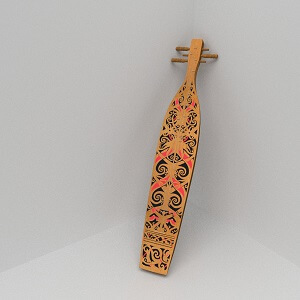Sape
 The Sape (in Kenyah dialect means ‘scratching’) is a traditional plucked lute chordophone family of instruments used by many of the Orang Ulu (Kayan, Kenyah, Kelabit), or ‘upriver people’, who live in the longhouses that line the rivers of Central Borneo and Kalimantan. Sape originated from the Long Nawang, Kabupaten Bulungan at the border of Sarawak, Malaysia, and East Kalimantan, Indonesia.
The Sape (in Kenyah dialect means ‘scratching’) is a traditional plucked lute chordophone family of instruments used by many of the Orang Ulu (Kayan, Kenyah, Kelabit), or ‘upriver people’, who live in the longhouses that line the rivers of Central Borneo and Kalimantan. Sape originated from the Long Nawang, Kabupaten Bulungan at the border of Sarawak, Malaysia, and East Kalimantan, Indonesia.
The story wants the idea of the Sape to come through a dream of a farmer who fell asleep in the hut of his paddy field after returning from seeking a witch-doctor to cure his wife’s sickness. In his dream, the farmer was directed to look for Adau wood, from the trees that the Hill Myna birds used to perch. The shape of Sape appeared in his dream and whenever the Sape was played, he dreamt the spirit would come and cure his wife’s sickness.
Sapes are carved from a single bole of selected fine grain wood, with many modern instruments reaching over a metre in length. Initially, the Sape was a fairly limited instrument with no design. It had two strings and only three frets (the three frets only appearing around the second decade of the 19th Century). Its use was restricted to a form of ritualistic music to induce trance. Still today, the Orang Ulu people believe that when there is any death in the longhouse, the Sape should not be played since it would cause the musician to become deaf, a condition only possible to cure with the sound of gongs called Tawak.